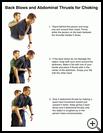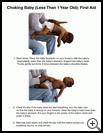
Choking
What is choking?
Choking is the coughing spasm and sputtering that happen when liquids or solids get into the windpipe. A child's cough reflex will clear the windpipe of liquid within 10 to 30 seconds. Complete blockage occurs when solid food (for example, a piece of hot dog) or a foreign object (such as a small toy) gets stuck. (It can also occur with severe croup.) If this happens a child is unable to breathe, cry, or speak. The child will be in a state of panic and, if the obstruction isn't removed in 1 or 2 minutes, the child will pass out.
What should I do if my child is choking?
Encourage coughing.
As long as your child is breathing and coughing, do nothing except encourage him to cough the material up by himself. The main purpose of your child's cough reflex is to clear the windpipe. Don't give your child anything to drink because fluids may take up space needed for the passage of air.
Give FIRST AID.
IF BREATHING STOPS in a child OVER 1 YEAR OLD, give high abdominal thrusts.
- Grasp the child from behind, just below the lower ribs but above the navel, in bear-hug fashion.
- Make a fist with one hand and fold the other hand over it.
- Give a sudden upward and backward jerk (at a 45-degree angle) to try to squeeze all the air out of the chest and pop the lodged object out of the windpipe.
- Repeat this upward thrust 10 times in rapid succession, until the object comes out.
- If the child is too heavy for you to suspend from your arms, lay him on his back on the floor. Put your hands on both sides of the abdomen, just below the ribs, and apply sudden, strong bursts of upward pressure.
IF BREATHING STOPS in an infant UNDER 1 YEAR OLD, give back blows and chest thrusts.
- Place infant facedown over your forearm (or legs) with the head lower than the chest.
- Give 5 back blows between the shoulder blades with your hand.
- If breathing has not resumed, turn the infant over, again keeping the head lower than the chest. Give 5 chest thrusts over the center of the chest just below the nipple line. Use 2 fingers and depress the breastbone at least 1 inch. (1/3 of the way to the back)
- Alternate back blows and chest thrusts until the object comes out, breathing returns, or the infant becomes unconscious.
Reason to avoid abdominal thrusts until 1 year old: risk of liver or spleen laceration.
IF THE CHILD OR INFANT BECOMES UNCONSCIOUS (UNRESPONSIVE), begin chest compressions (hands-only CPR).
- Call 911, if no one has already done so.
- Quickly open the mouth and look inside to see if there is any object that can be removed with a sweep of your finger (usually there is not). Do not perform a blind finger sweep.
- Place the child on the back on a firm surface and begin chest compressions at a rate of 100 per minute.
- If you know advanced CPR, also begin rescue breathing in a cycle of 2 rescue breaths for every 30 chest compressions.
Call the rescue squad (911) IMMEDIATELY.
Call the rescue squad (911) immediately in all cases of choking on a solid object.
In general, choking on liquids is temporary and harmless. Call the rescue squad if your child chokes on a liquid and turns blue, becomes limp, or passes out.
How can choking be prevented?
Choking can be life-threatening, so try to prevent it from happening by not giving young children foods or small objects that are most likely to cause choking.
Foods that are most likely to cause choking are nuts of any kind, sunflower seeds, orange seeds, cherry pits, watermelon seeds, gum, hard candies, popcorn, raw carrots, raw peas, raw celery, and tough meats. Do not give these hard foods to children who are less than 4 years old. They do not have enough molar teeth to chew them well and they may not understand that some seeds should be spat out rather than swallowed.
The soft foods that most often cause complete blockage and death are hot dogs, sausages, large pieces of any meat, grapes, gummy candy, and caramels. These foods must be avoided or chopped up before serving. Warn babysitters and older siblings not to share these foods.
Choking on a rubber balloon is the leading cause of deaths resulting from choking on objects other than foods. Most incidents occur when children suddenly inhale a deflated balloon they have been chewing. Warn your child never to chew or suck on pieces of rubber balloons. Even teenagers have died from this freak accident. Chewing on an inflated balloon is also dangerous because it could burst. Mylar helium balloons are much safer. Rubber balloons should only be used with strict supervision. Other items that can cause choking in young children include coins, marbles, pen or marker caps, and small button-type batteries.
Last modified: 2013-08-20
Last reviewed: 2017-06-05


